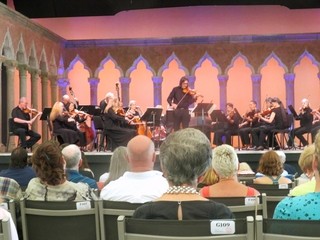|
Back
Effortless Pleasantries in the Carmoor Gardens New York
Katonah (Caramoor Center for Music and the Arts, Venetian Theater)
08/08/2021 -
Johann Sebastian Bach: Violin Concertos in A Minor, BWV 1041, in E Major, BWV 1042, & in D Minor, BWV 1052R
Orchestra of St. Luke’s, Leonidas Kavakos (Violinist/Conductor)

L. Kavakos, St.Luke’s in Venetian Theater (© Samuel A. Dog)
“It is as though eternal harmony were conversing with itself, as it may have happened in God’s bosom before he created the world.”
Johann Wolfgang von Goethe, on hearing Bach’s organ works
“Too much counterpoint–and what is worse, Protestant counterpoint.”
Sir Thomas Beecham, on hearing Bach’s organ works.
The word “timeless” has philosophical, cosmological, aesthetic and yes, durational meanings. Leonidas Kavakos summoned up his effortless virtuosity for Johann Sebastian Bach’s three violin concertos yesterday afternoon. And while the duration was literally about an hour, the notes swept through the great tent of Caramoor’s Venetian Theater in one timeless extravaganza.
The concert, with the Bach-sized Orchestra of St. Luke’s, was hardly perfect. But perfection is apt to be boring. Instead, we had the secular Bach, devoid of Kyries, lacking Hosannahs, giving a human accounting of violin and orchestra.
Yet that barely made up for the faults. That fault was hardly Mr. Kavakos. Each time I have heard him, he offers a glittering performance, whether Bartók, Brahms, or the most stunning execution of Korngold’s Violin Concerto. One would not like to pigeonhole him a Late Romantic exponent. For his playing is shimmering, effortlessly virtuosic, with a clear mastery of his instrument for any period.
So what happened yesterday afternoon? Partly, this was a problem with the Caramoor Venetian Theater tent. It is ideal for soloists, or for grand extravaganzas like John Luther Adams’ avian epic. But in these Baroque concertos, the textures seemed blurred, Mr. Kavakos’ playing–outside of the short solo cadenzas or Adagios–seemed little more than that of a Concertmaster.
Both the Orchestra of St. Luke’s and Mr. Kavakos (who served, in the Baroque style as conductor and soloist) did gain their acoustic footing in the final D Minor Concerto. That work has had a questionable history, as it seemed to have been rewritten from a harpsichord concerto, itself rewritten from an earlier violin concerto.
Never mind that. The D Minor is the most serious, the most inward of the three. Here too St. Luke’s separated themselves from the soloist. The genesis of this might have come from Bach himself. The first two “dedicated” concertos might well have been written by a composer who didn’t have much to do in strict barely-music-tolerant Cöthen. Like Graham Greene’s “entertainments”, they were written for friendly fiddlers.
This D Minor, because it was a reconstructed third transformation from other hands, was more challenging. Bach even employed “modern” techniques Mr. Kavakos himself accompanied the orchestra for its first theme. In the same movement, he played drones on his two low strings, while handling the soaring notes on the top. Both he and the ensemble rose to the occasion, and the dancing finale showed Bach at his most genial.
The first two concertos were...well, pleasant, amiable. One could forget occasional lacks of synchronization between soloist and ensemble, simply because Mr. Kavakos is such an amiable performer. Yesterday, his Strad glistened, glowed. He was never ever flashy, he let the music flow effortlessly, never parading his unerring skill.
In fact, the sheer uncritical enjoyment of the concert was due to Mr. Kavakos’ self-effacing joy.
The two slow movements were memorable. For the E Major Concerto, Mr. Kavakos offered what seemed like improvisation. (It wasn’t: Bach carefully wrote this out.)
And the Andante of the A Minor Concerto was like a chiaroscuro painting. The shade was provided by the Orchestra of St. Luke’s, whose repeated cadences were pointed, almost staccato. The light came from Mr. Kavakos, playing melodiously, with a quiet fluidity against the orchestra.
Moments like these gave this final concert of the Caramoor season an all too rare artistic luminosity.
Harry Rolnick
|